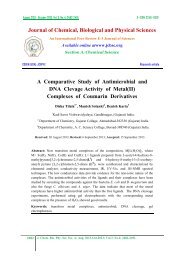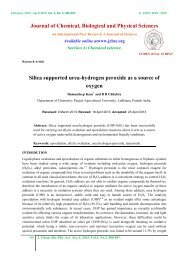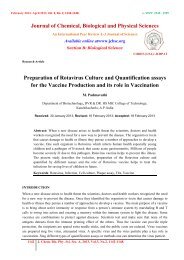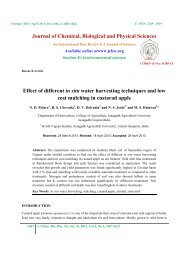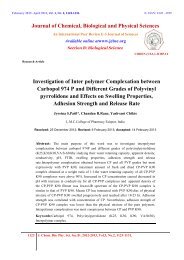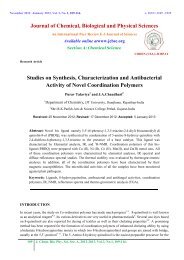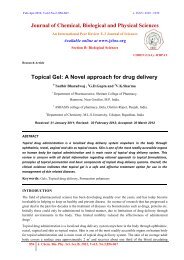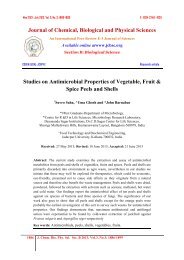an efficient catalyst for synthesis of 2-aryl-benzimidazole derivatives
an efficient catalyst for synthesis of 2-aryl-benzimidazole derivatives
an efficient catalyst for synthesis of 2-aryl-benzimidazole derivatives
Create successful ePaper yourself
Turn your PDF publications into a flip-book with our unique Google optimized e-Paper software.
E- ISSN: 2249 –1929Journal <strong>of</strong> Chemical, Biological <strong>an</strong>d Physical SciencesAn International Peer Review E-3 Journal <strong>of</strong> SciencesAvailable online at www.jcbsc.orgResearch ArticleSection A: Chemical sciencePhenylboronic acid: <strong>an</strong> <strong>efficient</strong> <strong>catalyst</strong> <strong>for</strong><strong>synthesis</strong> <strong>of</strong> 2-<strong>aryl</strong>-<strong>benzimidazole</strong> <strong>derivatives</strong>S<strong>an</strong>tosh V. Goswami, Prash<strong>an</strong>t B. Thorat, Vijay N. Kadam <strong>an</strong>d Sudhakar R. Bhusare*Department <strong>of</strong> Chemistry, Dny<strong>an</strong>opasak College, Parbh<strong>an</strong>i-431 401, MS, IndiaReceived: 8 August 2011; Revised: 29August; Accepted: 7September 2011ABSTRACTA simple <strong>an</strong>d <strong>efficient</strong> method has been described <strong>for</strong> the <strong>synthesis</strong> <strong>of</strong> 2-<strong>aryl</strong>- <strong>benzimidazole</strong><strong>derivatives</strong> from o-phenylenediamine <strong>an</strong>d aromatic aldehydes using a mild phenylboronic acid as a<strong>catalyst</strong> at ambient temperature condition.Key words: 2-Aryl-<strong>benzimidazole</strong>, aromatic aldehyde, o-phenylenediamine, phenylboronic acid.INTRODUCTIONThe heterocyclic nucleus <strong>benzimidazole</strong> containing org<strong>an</strong>ic molecules have found to besignific<strong>an</strong>t structural element in medicinal chemistry owing to its diverse biological activities.Benzimidazoles are also being developed as DNA minor groove binding agents with <strong>an</strong>titumoractivity 1 . Benzimidazole nucleus is acts as a lig<strong>an</strong>d to tr<strong>an</strong>sition metal, which will be more import<strong>an</strong>t<strong>for</strong> modeling biological systems.Benzimidazole <strong>derivatives</strong> exhibit signific<strong>an</strong>t activity against several viruses such as HIV, herpes(HSV-1), RNA, influenza, <strong>an</strong>d hum<strong>an</strong> cytomegalovirus (HCMV) 2 . The widespread interest in<strong>benzimidazole</strong> containing structures has promoted extensive studies <strong>for</strong> their <strong>synthesis</strong>. While m<strong>an</strong>ystrategies are available <strong>for</strong> <strong>benzimidazole</strong> <strong>synthesis</strong>, there are two general methods <strong>for</strong> the <strong>synthesis</strong> <strong>of</strong>2-substituted <strong>benzimidazole</strong>s. One is the coupling <strong>of</strong> o-phenylenediamine <strong>an</strong>d carboxylic acids ortheir <strong>derivatives</strong> (nitriles, imidates, or orthoesters), which <strong>of</strong>ten requires strong acidic conditions, <strong>an</strong>dsometimes combines with very high temperatures or microwave irradiation. The other way involves atwo-step procedure that includes the oxidative cyclo-dehydrogenation <strong>of</strong> Schiff bases, which are <strong>of</strong>tengenerated from the condensation <strong>of</strong> phenylenediamine <strong>an</strong>d aldehydes. Various oxidative <strong>an</strong>d catalyticJ. Chem. Bio. Phy. Sci. 2011, Vol.1, N0.2, Sec.A, 164-168. 164
Phenylboronic acid.....Sudhakar R. Bhusare et al.reagents such as DDQ 3 , Air 4 , sulfamic acid 5 , I 6 2 , FeCl 3·6H 2 O 7 , Oxone 8 , In(OTf) 9 3 , Yb(OTf) 10 3 ,Sc(OTf) 11 3 , KHSO 4 , IL 12 have been employed. Because <strong>of</strong> the availability <strong>of</strong> a vast number <strong>of</strong>aldehydes, the condensation <strong>of</strong> o-phenylenediamine <strong>an</strong>d aldehydes has been extensively used. Whilem<strong>an</strong>y published methods are effective, some <strong>of</strong> these methods suffer from one or more disadv<strong>an</strong>tagessuch as high reaction temperature, prolonged reaction time, <strong>an</strong>d toxic solvents etc. There<strong>for</strong>e, thediscovery <strong>of</strong> mild <strong>an</strong>d practicable routes <strong>for</strong> <strong>synthesis</strong> <strong>of</strong> 2-substituted <strong>benzimidazole</strong>s continues toattract the attention <strong>of</strong> researchers.In recent years, solvent-free <strong>synthesis</strong> <strong>of</strong> <strong>benzimidazole</strong>s under microwave irradiation using KSFclay 13 , PPA 14 , metal halide supported alumina 15 <strong>an</strong>d solid support 16 have been reported. Un<strong>for</strong>tunately,m<strong>an</strong>y <strong>of</strong> these processes suffer some limitations, such as drastic reaction conditions, low yields,tedious work up procedures <strong>an</strong>d co-occurrence <strong>of</strong> several side reactions 17 .Here in we report first time the use <strong>of</strong> phenylboronic acid as <strong>catalyst</strong> <strong>for</strong> the <strong>synthesis</strong> <strong>of</strong> 2-<strong>aryl</strong><strong>benzimidazole</strong>(Table-1) starting from o-phenylenediamine <strong>an</strong>d aromatic aldehydes at ambienttemperature conditions. Boronic acids are mild Lewis acids which are generally stable <strong>an</strong>d easy toh<strong>an</strong>dle, making them import<strong>an</strong>t to org<strong>an</strong>ic <strong>synthesis</strong>. Phenylboronic acid is used in numerous crosscoupling reactions. Moreover in the C-C bond <strong>for</strong>ming processes commonly use phenylboronic acidas a reagent.Table 1: Effect <strong>of</strong> phenylboronic acid on <strong>synthesis</strong> <strong>of</strong> 2-<strong>aryl</strong>-<strong>benzimidazole</strong> <strong>derivatives</strong>Entry Phenylboronic acid Product Time Yield (%) a(Mol %)(min)1 0 3a 45 trace2 5 3a 40 683 10 3a 20 754 15 3a 20 755 20 3a 20 906 25 3a 20 82a Isolated yield.EXPERIMENTALMelting points were determined in open capillary tube <strong>an</strong>d are uncorrected. The purity <strong>of</strong> thecompounds has been checked by TLC. The IR spectra were recorded on Vari<strong>an</strong> FTIR 640spectrometer. 1 H NMR spectra were recorded on Burker 300 MHz spectrometer in CDCl 3 as a solvent<strong>an</strong>d TMS as <strong>an</strong> internal st<strong>an</strong>dard.Typical procedure <strong>for</strong> Synthesis <strong>of</strong> 2-<strong>aryl</strong>-<strong>benzimidazole</strong>s: A mixture <strong>of</strong> aromatic aldehyde (10m.mol), o-phenylenediamine (10 m.mol), ethyl alcohol (15 mL) was added catalytic amount <strong>of</strong>phenylboronic acid (20 mol %) <strong>an</strong>d reaction mixture was stirred at room temperature <strong>for</strong> appropriatetime (Table 2- 3). After the completion <strong>of</strong> reaction indicated by thin layer chromatography (pet ether:ethyl acetate; 8:2), reaction mixture was poured into crushed ice. Obtained precipitate was filtered <strong>an</strong>ddried to give pure product Scheme 1. All <strong>of</strong> the compounds are identified from their spectral data <strong>an</strong>dby comparing their melting points with those reported in literature.J. Chem. Bio. Phy. Sci. 2011, Vol.1, N0.2, Sec.A, 164-168. 165
Phenylboronic acid.....Sudhakar R. Bhusare et al.Table 2: Effect <strong>of</strong> solvents on <strong>synthesis</strong> <strong>of</strong> 2-<strong>aryl</strong>-<strong>benzimidazole</strong> <strong>derivatives</strong>Entry Phenylboronic acid Solvent Time Yield (%) a(Mol %)(min)1 20 DCM - -2 20 DMF 35 563 20 CH3CN 25 524 20 H20 40 685 20 EtOH 20 90a Isolated yield.Table 3: Synthesis <strong>of</strong> 2-<strong>aryl</strong>-benzimdazole:Entry R Product Time(min)Mp (°C)Yield (%) a1 4-Cl 3a 20 285-2882 902 4-NO 2 3b 25 310-3112 823 2-Cl 3c 10 228-2302 854 2-Br 3d 15 230-231 845 2-OH 3e 30 205-206 756 4-OCH 3 3f 40 220-2232 777 4-CN 3g 45 255-257 888 3,4-(OCH 3 ) 2 3h 35 230-231 829 3-NO 2 3i 25 198-2012 8610 4-H 3j 20 284-2872 8211 4-CH 3 3k 30 264-2652 8512 5-Br, 2-OH 3l 35 241-242 78a Isolated yield.Spectral data <strong>of</strong> representative compounds:(3a) 2-(4-Chlorophenyl)-(1H)-<strong>benzimidazole</strong>: IR (KBr): 3042, 1452, 1408, 1278, 968, 750 cm-1;1 H-NMR (300 MHz, CDCl 3 ): δ 7.19-7.79 (m, 6H), 8.20 (d, 2H), 12.9 (s, 1H); Mass (LC/MS): m/z229.225 (M+); Anal. Calcd <strong>for</strong> C 13 H 9 ClN 2 : C, 68.28; H, 3.97; Cl, 15.50; N, 12.25 Found: C, 68.31; H,3.98; Cl, 15.52; N, 12.23.J. Chem. Bio. Phy. Sci. 2011, Vol.1, N0.2, Sec.A, 164-168. 168
Phenylboronic acid.....Sudhakar R. Bhusare et al.(3i) 2-(3-Nitrophenyl)-(1H)-<strong>benzimidazole</strong>: IR (KBr): 3053, 1530, 1443, 1352, 983, 748 cm-1; 1 HNMR (300 MHz, CDCl 3 ): δ 7.20-7.79 (m, 4H), 8.41 (m, 4H), 13.1 (s, 1H); Mass (LC/MS): m/z238.224 (M+); Anal. Calcd <strong>for</strong> C 13 H 9 N 3 O 2 : C, 65.27; H, 3.79; N, 17.56; O, 13.38 Found: C, 65.29; H,3.81; N, 17.53; O, 13.36.RESULT AND DISCUSSIONIn order to find out most favorable condition <strong>for</strong> the <strong>synthesis</strong> <strong>of</strong> 2-<strong>aryl</strong>-<strong>benzimidazole</strong>, a modelreaction is per<strong>for</strong>med using different ratios <strong>of</strong> phenylboronic acid as <strong>catalyst</strong> with o-phenylenediamine<strong>an</strong>d p-chlorobenzaldehyde. We found that very little <strong>of</strong> the desired product was obtained in theabsence <strong>of</strong> phenylboronic acid <strong>an</strong>d the best yields were obtained with 20% phenylboronic acid (Table(1). We have also made sure the effect <strong>of</strong> solvent on reaction rate using different solvents likedichlorometh<strong>an</strong>e, dimethyl<strong>for</strong>mamide, acetonitrile, water <strong>an</strong>d eth<strong>an</strong>ol. Our observations are presentedin Table 3 that the eth<strong>an</strong>ol st<strong>an</strong>ds to be the best solvent <strong>of</strong> choice, with its shorter reaction time <strong>an</strong>dhigh yield.Our results demonstrate that phenylboronic acid is very effective, environmentally friendly<strong>catalyst</strong> <strong>for</strong> the <strong>synthesis</strong> <strong>of</strong> 2-<strong>aryl</strong>-<strong>benzimidazole</strong> <strong>derivatives</strong> in good to excellent yields. The method<strong>of</strong>fers several adv<strong>an</strong>tages such as mild reaction conditions, short reaction time, high yields, <strong>an</strong>d asimple experimental operation leading to a useful <strong>an</strong>d attractive process <strong>for</strong> the preparation <strong>of</strong> 2-<strong>aryl</strong><strong>benzimidazole</strong><strong>derivatives</strong>.CONCLUSIONIn summary, we have demonstrated a novel <strong>an</strong>d facile method <strong>for</strong> the <strong>synthesis</strong> <strong>of</strong><strong>benzimidazole</strong>s by using phenylboronic acid as a promoter under mild reaction conditions. Theadv<strong>an</strong>tages <strong>of</strong> the present method include high yields <strong>of</strong> products, simple experimental procedure <strong>an</strong>dnon-toxicity <strong>of</strong> the reagent. The product were obtained were isolated in satisfactory yields byconventional work up. Both <strong>an</strong>alytical <strong>an</strong>d spectroscopic data <strong>of</strong> synthesized compounds are in fullagreement with the proposed structures.ACKNOWLEDGEMENTWe acknowledge Dr. P. L. More <strong>an</strong>d Dr. W. N. Jadhav, Dny<strong>an</strong>opasak College, Parbh<strong>an</strong>i <strong>for</strong>providing necessary facilities <strong>an</strong>d Fin<strong>an</strong>cial support <strong>for</strong> this work by DST-SERC, New Delhi(SR/FT/CS-023/2008) is highly appreciated.REFERENCES1. M. Kidwai, A. Jah<strong>an</strong>, D. Bhatnagar, J. Chem. Sci. 2010, 122, 607.2. H. Xi<strong>an</strong>gming, M. Huiqi<strong>an</strong>g, W. Yulu, Arkivoc 2007, 13, 150.3. K. J. Lee, K. D. J<strong>an</strong>da, C<strong>an</strong>. J. Chem. 2001, 79, 1556.4. S. Lin, L. Y<strong>an</strong>g, Tetrahedron Letter 2005, 46, 4315.5. M. Chakrabarty, S. Karmakar, A. Mukherji, S. Arima., Y. Harigaya, Heterocycles2006, 68, 967.J. Chem. Bio. Phy. Sci. 2011, Vol.1, N0.2, Sec.A, 164-168. 167
Phenylboronic acid.....Sudhakar R. Bhusare et al.6. P. Gogoi, D. Konwar, Tetrahedron Letter 2006, 47, 79.7. M. P. Singh, S. Sasmal, W. Lu, M. N. Chatterjee, Synthesis 2000, 10, 1380.8. P. L. Beaulieu, B. Hache, E. Von Moos, Synthesis 2003, 11, 1683.9. C. Massimo, E. Fr<strong>an</strong>cesco, M. Fr<strong>an</strong>cesca, Synlett 2004, 10, 1832.10. T. Itoh, K. Nagata, H. Ishikawa, A. Ohsawa, Heterocycles 2004, 63, 2769.11. H. Q. Ma, Y. L. W<strong>an</strong>g, J. P. Li, J. Y. W<strong>an</strong>g, Heterocycles 2007, 71, 135.12. R. R. Nagawade, D. B. Shinde, Chinese Chemical Letters 2006, 17, 453.13. A. Loupy, A. Petit, J. Hamelin, Synthesis 1998, 9, 1213.14. J. Lu, B. Y<strong>an</strong>g, Y. Bai, Synth. Commun. 2002, 32, 3703.15. G. V. Reddy, V. V. N. S. Ramarao, B. Narsaiah, Synth. Commun. 2002, 32, 2467.16. G. Penieres, I. Bonifas, G. Lopez, Synth. Commun. 2000, 30, 2191.17. J. R. Kumar, J. Jawahar, D. P. Pathak, E-Journal <strong>of</strong> Chemistry 2006, 13, 278.*Correspondence Author: Dr. S.R. Bhusare, Department <strong>of</strong> Chemistry,Dny<strong>an</strong>opasak College, Parbh<strong>an</strong>i-431 401, MS, IndiaJ. Chem. Bio. Phy. Sci. 2011, Vol.1, N0.2, Sec.A, 164-168. 168



